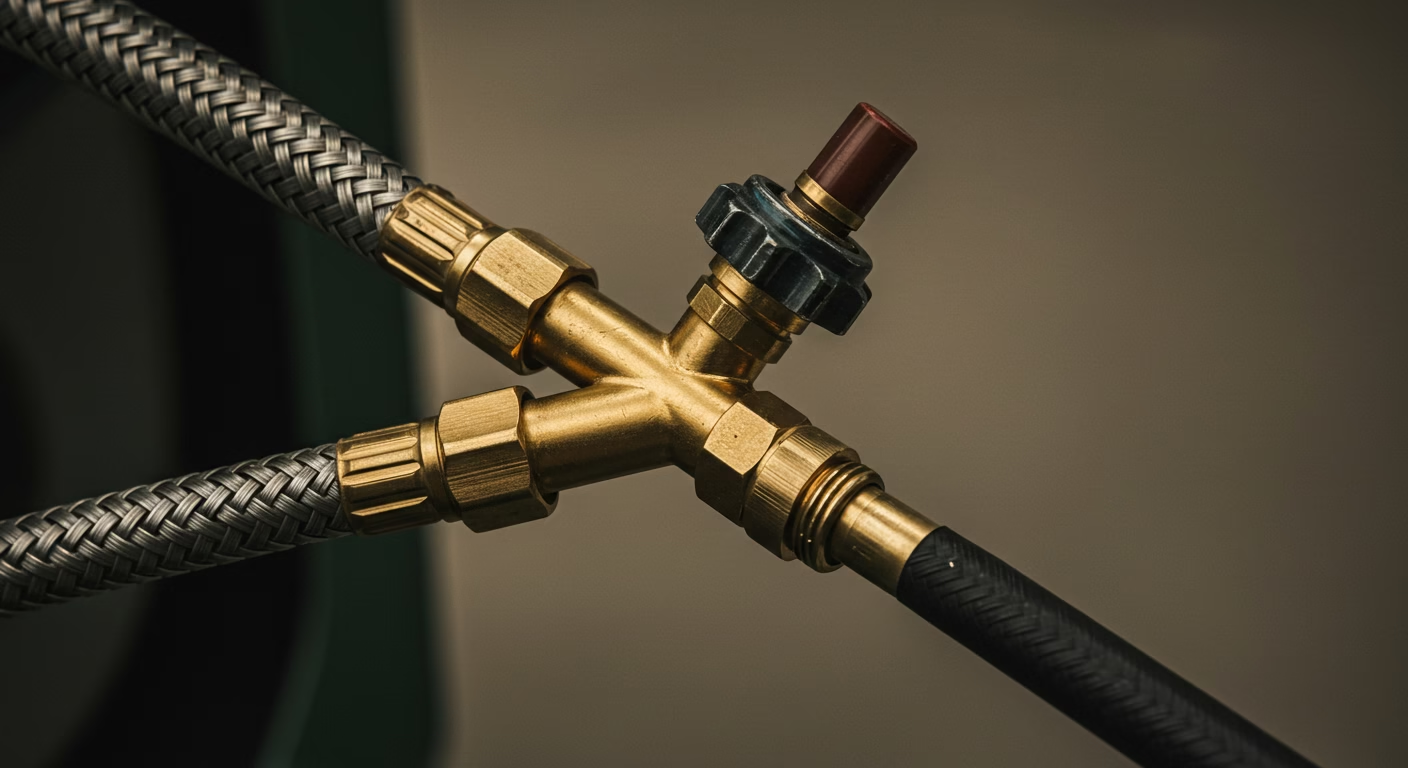GUIDE
Oxygen and Acetylene Hoses: A Comprehensive Guide

Oxygen and acetylene hoses are critical components in gas welding and cutting operations. These hoses transport gases from the cylinders to the torch, ensuring a steady and controlled flow for precise work. Given the flammable nature of acetylene and the oxidizing properties of oxygen, using the correct hoses is essential for safety and efficiency.
This article explores the key aspects of oxygen and acetylene hoses, including their construction, safety standards, maintenance, and best practices for handling.
1. Understanding Oxygen and Acetylene Hoses
Purpose and Function
Oxygen and acetylene hoses are designed to:
-
Safely transport gases under pressure.
-
Resist chemical reactions with the gases they carry.
-
Withstand wear, abrasion, and environmental factors.
Key Differences Between Oxygen and Acetylene Hoses
While both hoses serve similar purposes, they have distinct characteristics:
| Feature | Oxygen Hose | Acetylene Hose |
|---|---|---|
| Color Coding | Green (US) / Blue (EU) | Red (US & EU) |
| Gas Compatibility | High-pressure oxygen | Acetylene & other fuel gases |
| Construction | Reinforced inner lining for oxidation resistance | Designed to prevent acetone degradation |
2. Construction and Material Composition
Layers of a Welding Hose
A typical oxygen or acetylene hose consists of:
-
Inner Tube – Made of synthetic rubber resistant to gas permeation.
-
Oxygen hoses use non-reactive materials to prevent combustion.
-
Acetylene hoses must resist acetone (used to stabilize acetylene).
-
-
Reinforcement Layer – Fabric or braided textile for strength.
-
Outer Cover – Durable rubber to protect against abrasion, oils, and weather.
Why Different Materials Matter
-
Oxygen hoses must avoid oil contamination (risk of explosion).
-
Acetylene hoses must handle dissolved acetone without degrading.
3. Safety Standards and Regulations
Industry Standards
-
US (OSHA & CGA):
-
Oxygen hoses must meet CGA E-1 standards.
-
Acetylene hoses must comply with CGA E-7.
-
-
EU (EN 559 & EN 739):
-
Requires color-coding and pressure ratings.
-
Pressure Ratings
-
Working Pressure: Typically 200-300 psi for acetylene, up to 400 psi for oxygen.
-
Burst Pressure: At least 4x the working pressure.
4. Proper Handling and Maintenance
Inspection Guidelines
Before each use, check for:
✅ Cracks, cuts, or abrasions
✅ Soft spots or bulges (indicate internal damage)
✅ Leaks (use soapy water to detect bubbles)
Storage Best Practices
-
Avoid sunlight and extreme temperatures.
-
Coil loosely to prevent kinks.
-
Keep away from oils and solvents.
Common Hazards & How to Avoid Them
| Hazard | Risk | Prevention |
|---|---|---|
| Oil Contamination (Oxygen Hose) | Explosion | Never use oil-based lubricants |
| Acetylene Hose Degradation | Gas leaks | Replace hoses every 5 years |
| Kinks and Twists | Restricted gas flow | Use proper hose reels |
5. Choosing the Right Hose
Factors to Consider
-
Length: Longer hoses reduce maneuverability but increase reach.
-
Diameter: Thicker hoses allow higher flow rates.
-
Temperature Range: Some hoses are rated for extreme cold/heat.
Top Brands in the Market
-
TIGERFLEX – Known for flexibility and durability.
-
Parker Hannifin – High-pressure industrial hoses.
-
Flexzilla – Lightweight and kink-resistant.
6. Troubleshooting Common Issues
Problems
01: Hose Keeps Kinking
-
Solution: Use a hose with better flexibility or install a spring guard.
02: Gas Leak at Connections
-
Solution: Tighten fittings or replace worn O-rings.
03: Hose Hardening Over Time
-
Solution: Replace the hose (aged rubber loses elasticity).
Burning Questions About Welding’s Lifelines
1. Why do pro welders hate green hoses?
✅ Answer: “The Color Code Killswitch” – Red (fuel) and blue (oxygen) aren’t just tradition—mixing them up can turn your torch into a flamethrower. Green hoses? An accident waiting to happen.
2. Can a 5hose∗really∗causea50,000 explosion?
✅ Answer: Yes—if it’s reinforced wrong. Cheap hoses use textile braids that degrade fast. *Look for “T-grade” rubber with wire helix cores—or risk a leak at 250 PSI.*
3. What’s the secret behind NASA’s welding hoses?
✅ Answer: “The Kink-Proof Twist” – Their hoses have dual-layer coils that never collapse, even in zero gravity. Now available for civilian use (but costs more than your welder).
4. Why do acetylene hoses smell like garlic?
✅ Answer: It’s not the gas—it’s the mercaptan added to warn you of leaks. No scent? You’re already inhaling poison. Sniff test your hoses daily.
5. How long do hoses actually last? (Hint: Not what the box says)
✅ Answer: “The 3-Year Lie” – Manufacturers claim 5+ years, but sunlight, oil, and bends murder hoses in 18 months if not stored right. Check for cracks monthly.
6. What’s the deadliest hose repair “hack” on YouTube?
✅ Answer: “Duct Tape Over Bulges” – A swollen hose means internal decay—tape just hides the time bomb. Always replace, never patch.
7. Why do shipyard hoses survive saltwater but garage hoses rot?
✅ Answer: “Neoprene Armor” – Marine-grade hoses cost 2x more but resist UV, acid, and abrasion. Worth it if you weld near oceans (or spilt soda).
8. Can you microwave a frozen hose to thaw it?
✅ Answer: “Only If You Want a Fireball” – Ice expands inside the fibers. Thaw slowly at room temp—or hear the “pop” of ruptured liners.
9. What’s the military trick to coil hoses without damage?
✅ Answer: “The Figure-8 Fold” – Prevents kinks that weaken the core. Twist clockwise only—reverse wraps crush the inner wall.
10. Why do hospital oxygen hoses last 10x longer than welding ones?
✅ Answer: “Medical-Grade OCD” – They’re sterilized, kept dark, and never bent >45°. Copy this, and your hoses might outlive your career.
Conclusion
Oxygen and acetylene hoses form the lifeline of safe welding operations. These specialized tubes deliver crucial gases while withstanding intense workplace demands. Since improper hose use causes accidents, welders must prioritize quality selection and maintenance.
When choosing hoses, always verify their pressure ratings first. Look for durable rubber construction with color-coded identification. Typically, red marks acetylene lines while green identifies oxygen. Moreover, never interchange these hoses as contamination risks explosion.
Proper installation comes next after selection. First, secure connections with proper fittings and check for leaks. Then, route hoses away from heat and sharp edges. Furthermore, protect them from sparks and open flames during operation.
Regular inspections prevent most failures before they occur. Examine hoses weekly for cracks, burns or soft spots. Also check fittings for tightness and corrosion. If damage appears, replace components immediately rather than attempting repairs.
Storage practices greatly affect hose longevity. Always coil hoses loosely without kinks after use. Keep them in dry, temperature-controlled spaces when not working. Additionally, never expose stored hoses to direct sunlight or chemicals.
Oil contamination poses particular dangers to oxygen lines. Even small amounts can cause violent reactions. Therefore, maintain strict oil-free protocols around oxygen equipment. Similarly, never use petroleum-based products for cleaning.
Training remains essential for all welding personnel. New workers should learn proper handling techniques early. Likewise, experienced welders need refreshers on updated safety standards.
Following these guidelines ensures reliable gas delivery and prevents workplace injuries. While quality hoses represent an investment, they pay dividends in safety and performance. Ultimately, proper care protects both equipment and lives.
GUIDE
Troozer com Guide: Shopping Made Simple

In the modern world of e-commerce, platforms that combine innovation, affordability, and user-friendly experiences are highly valued. One such platform making waves is Troozer com. Known for its wide product selection, simple shopping process, and growing digital presence, Troozer com is quickly becoming a preferred choice for online shoppers looking for both value and variety.
This comprehensive guide explores Troozer com in detail, highlighting its usability, features, benefits, shopping experience, and how it stands out in today’s competitive online market.
What is Troozer com?
Troozer com is an online marketplace that provides shoppers with access to a broad selection of products across multiple categories. Unlike many generic platforms, Troozer com emphasizes affordability, convenience, and customer satisfaction, making it appealing to a wide range of users.
The platform has positioned itself as a growing player in the e-commerce space, offering shoppers the chance to find both everyday essentials and unique items from the comfort of their homes.
Key Features of Troozer com
-
Wide Product Variety
Troozer com covers multiple product categories, ensuring that shoppers can find almost everything they need in one place. -
User-Friendly Website Navigation
A simple and intuitive design makes browsing, selecting, and purchasing items straightforward even for first-time users. -
Competitive Pricing
Affordability is one of Troozer com’s strongest points, with many products available at budget-friendly rates. -
Secure Transactions
Online shopping requires trust, and Troozer com incorporates measures to ensure customer data and payment security. -
Accessibility for All
The platform’s structure and design cater to a wide audience, making online shopping less intimidating.
Benefits of Using Troozer com
Choosing Troozer com comes with numerous advantages:
-
Convenience – Shop from anywhere at any time.
-
Variety – From household items to lifestyle products, the range is impressive.
-
Affordability – Competitive prices without compromising on quality.
-
Time-Saving – Easy navigation ensures quick product discovery.
-
Growing Selection – Frequent updates with new and trending items.
Shopping Experience on Troozer com
The shopping journey on Troozer com is designed to be simple and seamless.
-
Product Browsing – Categories are neatly arranged for quick access.
-
Search Functionality – Allows users to locate specific items without hassle.
-
Cart and Checkout – Smooth process with minimal steps.
-
Customer Support – Provides assistance when needed, ensuring better shopping satisfaction.
For both new and returning shoppers, the experience is straightforward, efficient, and satisfying.
Who Should Use Troozer com?
Troozer com caters to a wide audience, including:
-
Everyday Shoppers – Looking for essentials at affordable prices.
-
Students – Searching for budget-friendly items.
-
Families – Wanting convenience and variety in one place.
-
Professionals – Needing efficient online shopping for busy lifestyles.
Essentially, anyone seeking a hassle-free shopping experience with a broad range of choices will benefit from using Troozer com.
Troozer com vs Other Marketplaces
While the online shopping space is competitive, Troozer com distinguishes itself with its:
-
Focused Value Proposition – Affordable prices with a wide range of items.
-
Ease of Use – User-friendly platform design.
-
Targeted Approach – Appeals to budget-conscious yet quality-seeking shoppers.
Compared to larger marketplaces, it may not be as extensive, but it makes up for it by being more streamlined and straightforward.
Popular Categories on Troozer com
Although product selections evolve over time, it often features items in the following categories:
-
Electronics and Gadgets – Budget-friendly options for tech enthusiasts.
-
Household Items – Essentials to simplify everyday living.
-
Clothing and Accessories – Affordable fashion choices.
-
Health and Lifestyle – Products designed for well-being and comfort.
-
Miscellaneous Finds – Unique and trending items not easily found elsewhere.
Why Troozer com Appeals to Shoppers
There are several reasons Troozer com resonates with its users:
-
Trust Factor – Reliability is key in e-commerce, and Troozer com focuses on transparency.
-
Customer-Centric Design – The website structure prioritizes ease of use.
-
Affordability – Shoppers can get more value for their money.
-
Expanding Presence – Constantly updating offerings to stay relevant.
SEO and Online Presence of Troozer com
Troozer com is steadily growing in online visibility, largely due to its niche approach in providing affordable and accessible products. It has become an increasingly searched platform, with users interested in finding budget-friendly deals.
Popular search keywords include:
-
Troozer com review
-
Troozer com products
-
Affordable shopping platforms
-
Online shopping made easy
-
Troozer com experience
These keywords help the platform attract its target audience while solidifying its identity in the e-commerce landscape.
Future of Troozer com
The future looks promising for Troozer com as online shopping continues to grow worldwide. By focusing on affordability, expanding product ranges, and maintaining customer satisfaction, the platform is set to gain even more traction.
Possible future developments may include:
-
Mobile App Launch – Offering greater convenience for smartphone users.
-
Expanded Categories – More diverse products catering to global shoppers.
-
Personalized Recommendations – AI-driven shopping suggestions to enhance the user experience.
-
Global Expansion – Reaching customers beyond its current market.
Tips for Shopping Smart on Troozer com
-
Compare Prices – Take advantage of competitive rates.
-
Check Categories Frequently – New items are often added.
-
Use Search Function – Saves time when looking for specific products.
-
Read Descriptions Carefully – Ensures that the product fits your needs.
-
Plan Purchases – Combine items in one order for efficiency.
Why Troozer com Stands Out
Troozer com is not just another online shopping platform. Its appeal lies in simplicity, affordability, and practicality. It doesn’t overwhelm users with complexity but instead provides a reliable and efficient shopping experience that works for everyday needs.
By focusing on delivering value, Troozer com builds trust with its audience while ensuring that the shopping process remains enjoyable and stress-free.
Conclusion
In today’s fast-paced e-commerce world, one platform has managed to carve out a strong reputation by focusing on three essential strengths: affordability, accessibility, and convenience. While countless marketplaces compete for attention, this shopping destination stands apart by delivering a budget-friendly and user-centered experience designed for everyday consumers.
For those seeking value without unnecessary complications, the platform consistently delivers. Its straightforward design allows users to browse, compare, and purchase items with ease, avoiding the frustrations of cluttered or overly complex websites. By keeping the shopping journey smooth and intuitive, it ensures customers can concentrate on what truly matters—finding quality products at fair prices.
A key attraction lies in the variety of products available. From everyday essentials to lifestyle goods, the marketplace covers a wide spectrum of needs, making it versatile enough to appeal to a broad audience. Its easy navigation, combined with dependable, customer-focused services, has helped build a loyal user base that values both simplicity and efficiency.
Looking ahead, this platform is not simply resting on its strengths but actively preparing for future opportunities. With rapid technological advancements, shifting consumer expectations, and the rising demand for seamless online shopping, it is well-positioned to expand its reach and influence within the industry.
Ultimately, in an era overflowing with flashy promises and endless options, this e-commerce destination proves that simplicity and affordability are still the strongest advantages. By staying focused on practical solutions and a customer-first approach, it continues to earn trust and loyalty, solidifying its position as a growing force in online retail.
BLOG
Used SciFit StepOne for Sale: The Complete Buyer’s Guide

When it comes to fitness equipment, few machines strike the perfect balance between functionality, rehabilitation support, and total body conditioning like the SciFit StepOne. Designed for both rehabilitation centers and home gyms, this recumbent stepper provides low-impact cardiovascular exercise while promoting joint mobility and muscle strength. Many fitness enthusiasts, medical facilities, and physical therapists recommend the StepOne because of its ability to accommodate users of all fitness levels.
If you are searching for a used SciFit StepOne for sale, you are likely interested in getting all the benefits of this high-end machine at a more affordable price. This guide will walk you through everything you need to know about the SciFit StepOne, including its features, benefits, reasons to buy used, what to look for before making a purchase, and tips for maintenance.
What is the SciFit StepOne?
The SciFit StepOne is a recumbent total body stepper. Unlike traditional treadmills or upright bikes, it provides a comfortable seated workout with simultaneous arm and leg movement. It’s widely used in rehabilitation clinics, hospitals, senior living centers, and fitness facilities, thanks to its ability to support users with limited mobility, balance issues, or joint pain.
Some of its standout features include:
-
Recumbent seated position for comfort and support
-
Independent arm and leg movement for upper and lower body conditioning
-
Adjustable resistance levels to suit beginners through advanced users
-
Smooth stepping motion that reduces stress on knees, hips, and joints
-
Accessibility features like a swivel seat, easy entry, and ADA compliance
-
User-friendly console with multiple workout programs
Because of its durability and adaptability, the SciFit StepOne is built to last. This makes buying a used model a smart option since even pre-owned machines can offer years of reliable use.
Why Choose the SciFit StepOne?
1. Rehabilitation and Recovery
The StepOne is ideal for individuals recovering from injuries, surgeries, or medical conditions. Its smooth stepping motion allows patients to gradually rebuild strength and improve range of motion without risk of high-impact stress.
2. Low-Impact Cardio
Unlike running or high-intensity exercises, the StepOne reduces strain on joints, making it an excellent choice for seniors or those with arthritis.
3. Full Body Workout
With independent arm and leg movement, users engage both the upper and lower body simultaneously, promoting balanced muscle development.
4. Accessibility
Its swivel seat and open design allow people with limited mobility to easily get on and off, which is a huge advantage in rehabilitation and senior care environments.
5. Proven Durability
SciFit designs equipment with medical-grade standards, ensuring long-lasting performance even with daily use in professional facilities.
Why Buy a Used SciFit StepOne?
Purchasing a brand-new StepOne can be expensive, especially for home users. However, the pre-owned market offers a more budget-friendly way to enjoy the same benefits. Here’s why you might consider a used model:
-
Significant Cost Savings: A new unit can be pricey, but a used SciFit StepOne typically costs much less while retaining most of its functionality.
-
Durability: Built for clinical use, these machines are engineered to last. Even when used, they remain reliable if properly maintained.
-
Availability: Many rehabilitation centers and gyms upgrade their equipment regularly, meaning there are always used StepOne units available for resale.
-
Eco-Friendly Choice: Buying used reduces waste and extends the lifecycle of quality equipment.
What to Look for When Buying a Used SciFit StepOne
If you’ve found a used SciFit StepOne for sale, you’ll want to make sure it’s in good condition before making the purchase. Here are some important things to check:
1. Overall Condition
Inspect the frame, seat, and console for signs of wear. Minor cosmetic issues are normal, but excessive rust, cracks, or broken parts may signal poor maintenance.
2. Resistance Functionality
Test different resistance levels to ensure the machine responds correctly. A machine that doesn’t adjust properly may require costly repairs.
3. Console and Electronics
Check the display screen and buttons. The console should show clear readings for time, distance, resistance, and other metrics.
4. Smoothness of Motion
Step through a workout to ensure the motion feels natural and fluid. Jerky or uneven movement may indicate mechanical issues.
5. Accessibility Features
Verify that the swivel seat rotates properly and locks into place. Accessibility is one of the StepOne’s key benefits.
6. Warranty and Service History
If possible, ask the seller for maintenance records or proof of service. Some sellers may even offer a limited warranty on used equipment.
Benefits of a Used SciFit StepOne for Home Gyms
Buying a used StepOne isn’t just about saving money—it’s also a smart investment for long-term health and fitness.
-
Rehabilitation at Home: Perfect for users who want to continue therapy at home after discharge from a clinic.
-
Family Fitness: Since it’s adjustable, multiple family members can use it, from seniors to young adults.
-
Space-Saving Design: Although sturdy, the StepOne has a relatively compact footprint compared to other rehab machines.
-
Motivation and Consistency: Having professional-grade equipment at home encourages regular workouts.
Tips for Maintaining a Used SciFit StepOne
A well-maintained machine will last for years, even if purchased used. Follow these maintenance tips:
-
Wipe Down Regularly – Clean sweat and dust from the console, seat, and handles after each session.
-
Inspect Moving Parts – Check pedals, arms, and seat adjustments for wear and lubricate if necessary.
-
Monitor Electronics – Ensure the console and resistance system are working properly. Replace batteries or cords if needed.
-
Professional Servicing – Schedule periodic checkups with a fitness equipment technician, especially if the machine is used frequently.
-
Proper Placement – Keep the StepOne in a dry, temperature-controlled environment to prevent rust and electronic damage.
Where to Find a Used SciFit StepOne for Sale
While we won’t provide direct links, here are some of the most common places where used StepOne units are found:
-
Fitness Equipment Resellers – Companies that refurbish and resell commercial gym equipment.
-
Medical and Rehabilitation Facilities – Some clinics sell older models when upgrading.
-
Classified Ads – Local listings may have great deals, especially if a seller is moving or downsizing.
-
Auction Sites – Fitness centers often liquidate equipment at auctions, providing opportunities for lower prices.
Is a Used SciFit StepOne Right for You?
The decision comes down to your fitness goals, budget, and intended use. If you need:
-
Low-impact, joint-friendly exercise
-
A rehabilitation tool for recovery
-
A reliable machine for seniors or individuals with limited mobility
-
A long-lasting piece of equipment at a reduced price
Then purchasing a used SciFit StepOne can be an excellent choice.
Final Thoughts
The SciFit StepOne is more than just a piece of exercise equipment—it’s a rehabilitation tool, a fitness enhancer, and a pathway to better mobility and health. While brand-new units can be costly, opting for a used SciFit StepOne for sale offers incredible value without compromising quality. By carefully checking the condition, ensuring smooth performance, and following maintenance guidelines, you can enjoy all the benefits of this professional-grade machine for years to come.
Whether you’re recovering from an injury, supporting senior wellness, or simply looking for low-impact cardio equipment, the StepOne remains one of the most effective and accessible solutions available. Investing in a used model is not only cost-effective but also a smart move toward sustainable fitness.
FASHION
Troozer com: A Complete Guide to Smart Online Shopping in 2025

In today’s fast-paced digital world, online shopping has become more than a convenience—it’s a lifestyle. People are always on the lookout for platforms that not only offer great products but also combine affordability, reliability, and modern technology. One such rising platform making waves in 2025 is Troozer com.
Designed for the modern shopper, it is more than just an e-commerce website—it’s a one-stop destination that connects users with a wide range of products while offering a seamless and secure shopping experience. Whether you’re looking for fashion, electronics, home essentials, or lifestyle products, Troozer com positions itself as a trusted online marketplace.
This article provides a complete breakdown of Troozer com, its features, product categories, benefits, and why it has become a top choice for online shoppers worldwide.
What is Troozer com?
Troozer com is an online shopping platform designed to simplify the customer journey. Unlike traditional websites that only focus on product listings, it emphasizes convenience, personalization, and variety. It caters to global shoppers by offering diverse categories, competitive prices, and a secure shopping environment.
The platform stands out because it’s built with modern e-commerce technology, ensuring faster browsing, smoother transactions, and tailored product recommendations.
Why Shoppers Choose Troozer com
There are countless online marketplaces, so what makes it worth exploring?
-
Wide Product Selection – From clothing and gadgets to home décor and lifestyle products.
-
User-Friendly Interface – Intuitive browsing and easy checkout.
-
Affordable Pricing – Products that balance quality with affordability.
-
Personalized Recommendations – Smart suggestions based on browsing and purchase history.
-
Security & Trust – Reliable payment gateways and customer support.
By offering these features, it appeals to both casual shoppers and those who buy frequently online.
Categories Available on Troozer com
Troozer com covers a wide range of shopping categories to suit different lifestyles. Here are some highlights:
1. Fashion & Apparel
-
Men’s Clothing: Suits, casual wear, streetwear, and accessories.
-
Women’s Fashion: Dresses, tops, handbags, and footwear.
-
Kids’ Fashion: Comfortable and stylish clothing for children.
2. Electronics & Gadgets
-
Smartphones, tablets, and smart accessories.
-
Headphones, speakers, and wearable tech.
-
Home electronics for modern living.
3. Home & Living
-
Furniture, décor, and kitchen essentials.
-
Bedding, storage, and lifestyle accessories.
-
Smart home solutions for convenience.
4. Health & Beauty
-
Skincare and makeup products.
-
Grooming essentials for men and women.
-
Wellness and fitness accessories.
5. Lifestyle Products
-
Travel essentials, backpacks, and luggage.
-
Sports gear and hobby-related items.
-
Seasonal collections and gift items.
This wide selection ensures that it caters to every shopper under one roof.
The Shopping Experience at Troozer com
What makes it different is how it focuses on experience. From the moment you log in, you’ll notice:
-
Smart Navigation: Categories are well-organized and easy to browse.
-
Personalized Deals: AI-driven technology tailors product recommendations.
-
Quick Checkout: Minimal steps from cart to payment.
-
Mobile-Friendly Access: Designed for shopping on the go.
This attention to detail transforms online shopping from a task into a smooth experience.
Troozer com in 2025: What’s New?
As technology advances, it continues to evolve. In 2025, the platform has introduced:
-
Sustainable Shopping Options – Eco-friendly brands and products.
-
Global Seller Partnerships – Expanding product availability worldwide.
-
AI-Driven Search – Smarter results based on natural language queries.
-
Customer Loyalty Programs – Rewards, points, and exclusive discounts.
-
Fast Delivery Services – Improved logistics to reduce waiting time.
These upgrades ensure it remains competitive in a growing digital marketplace.
Benefits of Shopping on Troozer com
Shopping on Troozer com comes with multiple advantages:
-
Convenience: Shop from anywhere, anytime.
-
Variety: Endless product categories for different needs.
-
Affordability: Deals and discounts make shopping budget-friendly.
-
Trust: Secure payments and verified sellers.
-
Personalization: Tailored recommendations to save time.
For customers, these benefits make Troozer com a dependable choice.
How Troozer com Ensures Security
Online shoppers often worry about security. Troozer com addresses this by:
-
Using encrypted payment gateways.
-
Verifying sellers to prevent fraud.
-
Offering clear return and refund policies.
-
Providing 24/7 customer support for queries.
These measures give shoppers peace of mind while making purchases.
Comparing Troozer com to Other Platforms
How does Troozer com compare with other e-commerce sites?
-
Amazon & eBay: Broader global reach but less personalized.
-
Specialty Stores: Focused categories but limited variety.
-
Troozer com: Balanced approach—wide variety with personalized and user-friendly experience.
This balance allows Troozer com to carve a niche among competitors.
Tips for Shopping Smart on Troozer com
To get the most out of it, here are some shopping strategies:
-
Sign Up for an Account: Access exclusive deals and rewards.
-
Use Filters: Narrow down choices faster.
-
Check Reviews: Learn from other buyers’ experiences.
-
Plan Seasonal Purchases: Look for sales during holidays.
-
Build a Wishlist: Save products for future purchases.
Smart shopping ensures maximum value from every purchase.
Troozer com and the Future of Online Shopping
The future of e-commerce is shifting toward personalized, sustainable, and fast shopping. Troozer com is preparing for this future by:
-
Introducing AI-driven personalization.
-
Expanding green and eco-friendly categories.
-
Enhancing logistics and delivery networks.
-
Exploring virtual reality shopping experiences.
With these advancements, troozer com is on track to become a global e-commerce leader.
Why Troozer com Appeals to Modern Shoppers
Today’s shoppers want more than products—they want experience, trust, and value. Troozer com delivers this through:
-
Smart Technology – AI and personalization.
-
Modern Lifestyle Fit – Products for fashion, tech, and living.
-
Global Access – Bridging local and international sellers.
-
Community Building – Reviews and engagement among shoppers.
This combination explains why Troozer com continues to attract customers worldwide.
Final Thoughts on Troozer com
E-commerce is a constantly evolving industry, and innovative platforms are proving how customer focus and creativity can redefine online shopping. By delivering variety, personalization, security, and affordability, this marketplace positions itself as a trusted shopping hub in 2025.
Whether you’re browsing for fashion, electronics, home goods, or beauty essentials, the platform ensures a seamless experience. It’s not just about purchasing products—it’s about enjoying a smarter, more personalized way to shop.
As the future of retail leans toward technology-driven personalization and sustainability, this online store is leading the way with solutions designed for modern lifestyles. For anyone seeking a reliable, stylish, and future-ready shopping destination, it’s definitely one to watch.
-

 EDUCATION5 months ago
EDUCATION5 months agoHCOOCH, CH₂, and H₂O: Key Molecules in Chemistry and Life
-

 BLOG4 months ago
BLOG4 months agoTeenthailand_11_SC1: Unveiling Thailand’s Youth Culture
-

 EDUCATION7 months ago
EDUCATION7 months agoQawerdehidom: Origins, Principles, and Modern Applications
-

 ENTERTAINMENT5 months ago
ENTERTAINMENT5 months agoWhat Are Coachella Co-Chairs: The Visionaries Behind the Iconic Festival
-

 BLOG5 months ago
BLOG5 months agoTheapknews.shop Health: Your Gateway to Wellness and Tech
-

 BLOG8 months ago
BLOG8 months agoPO18: A Comprehensive Guide to Its Meaning and Applications
-

 EDUCATION5 months ago
EDUCATION5 months agoNowCollege 1v1: Redefining Personalized Higher Education
-

 ART5 months ago
ART5 months agoKemono Nyl2: A Fusion of Art and Culture




